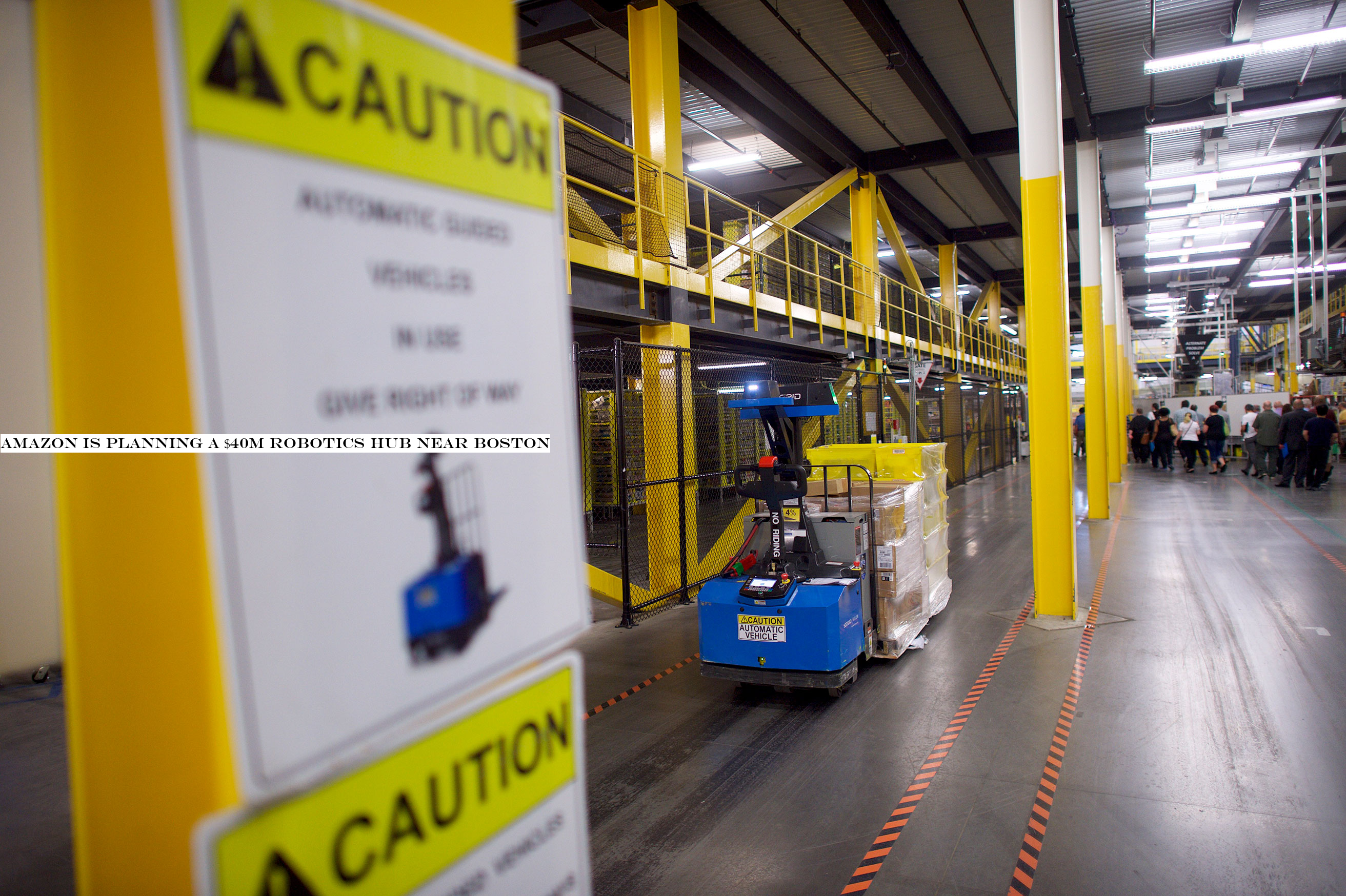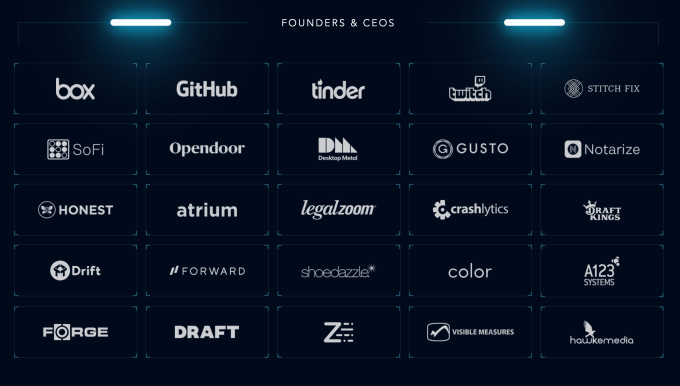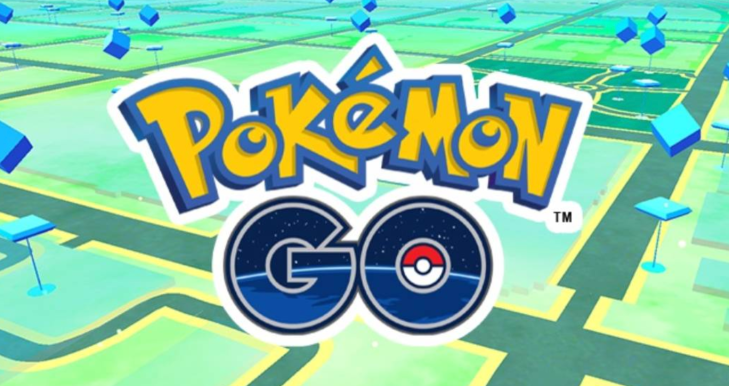Technology

Amazon announced a plan today to build a $40 million, 350,000-square-foot robotics innovation hub in Westborough, Mass. The new facility will bring 200 technology and advanced manufacturing jobs when it opens in 2021.
The new facility will include corporate offices, research and development labs and a robotics manufacturing space. The company said that this new facility will be in addition to its existing Amazon Robotics site in North Reading, Mass.
Tye Brady, chief technologist at Amazon Robotics, says the new hub will allow Amazon to continue to build on its robotics research. &This will be a world-class facility, where our teams can design, build, program and ship our robots — all under the same roof. This expansion will allow us to continue to innovate quickly and improve delivery speed for customers around the world,& Brady said in a statement.
Amazon bought Kiva Systems, a company that was developing order fulfillment robots, in 2012 for $775 million in cash, and then renamed the company Amazon Robotics. A lot has changed since 2012, and today the company has deployed more than 200,000 drive units in over 50 fulfillment centers worldwide, according to data supplied by the company.
Amazon is not new to Massachusetts. It has had a presence in the Bay State since 2011, and has invested more than $3 billion and created more than 4,000 full-time jobs in Massachusetts, according to data supplied by the company.
Westborough is a suburb located about 35 miles west of Boston.
- Details
- Category: Technology
Read more: Amazon is planning a $40M robotics hub near Boston
Write comment (91 Comments)Stealth fintech startup Digits, from the same team that built Crashlytics to scale then sold to Twitter for more than $100 million, has raised a $10.5 million round of Series A funding, the company is announcing today. The round was led by Benchmark and has the backing of 72 angels, including founders and CEOs from companies like Box, GitHub, Tinder, Twitch, StitchFix, SoFi and several others.
With the round, Digits also gains a new board member, Peter Fenton, who has served on the boards at AirTable, Twitter, NewRelic, Yelp and elsewhere.
The funding is a big bet on serial entrepreneurs Wayne Chang and Jeff Seibert, who launched and sold their crash reporting service to Twitter, which itself later sold it to Google. At Twitter, the team remained to build out the product and launch new services, like Answers. After the sale to Google four years later, it was then folded into Googleown developer platform to become the crash reporting tool for Android. Today, itstill on nearly 5 billion monthly active devices and used inside millions of apps.
Now, the Crashlytics co-founders have returned with most of their original team to develop a new fintech startup, Digits, which describes itself vaguely as &a counting company.&
The companyfocus aims to solve a problem the founders had faced themselves when building Crashlytics.
&As builders, there is nothing more exciting than cracking the next engineering puzzle; than perfecting the next design; than delivering the next capability to customers. And there is nothing more mind-numbing than the paperwork, and spreadsheets, and financial reports, and inscrutable transaction records that are all required to actually operate the business,& a Digits blog post earlier this year explained.
&Globally, most entrepreneurs today have no formal training in business finance. We certainly didn&t. Today, you start a company to solve a real problem for real people, or to offer a service you&re skilled at, or to provide a living for you and your family. You don&t start a company because you want to operate a business—but you have to anyway,& the founders said.
While Digits isn&t talking about the specifics of its new product yet, its software is described as pairing design and machine learning in order to &democratize financial savvy.&
More specifically, it leverages APIs, classification algorithms and machine learning techniques to provide a real-time view into a business& finances, proactively alert you to whatimportant and allow you to deep dive into your data to better understand whatdriving your business.

The company believes its approach to visualizing a companyfinances is unique, and apparently a sizable number of investors agree.
Among the 70+ angels backing Digits are Box CEO Aaron Levie; Adam Bain and Dick Costolo (ex COO and CEO of Twitter); Ali Rowghani (partner at Y Combinator, ex-COO Pixar); SoFi CEO Anthony Noto; Drift CEO David Cancel; AngelList board member Jeff Fagnan; Justin Kan (CEO Atrium, co-founder Twitch, YC partner); StitchFix CEO Katrina Lake; GitHub CEO Nat Friedman; First Republic Bank COO Mike Selfridge; Desktop Metal CEO Ric Fulop; Tinder co-founder Jonathan Badeen; DraftKings CEO Jason Robins; LegalZoom co-founder Brian Lee; Gusto CEO Josh Reeves; and Notazie CEO Pat Kinsel.
Though Digits hasn&t publicly launched — the product is in invite-only status for now — it already has live customers and is seeing more than $1.5 billion in transactions processing on its platform, the company says.
And unlike Crashlytics, which was based in Boston, Digits is a 100% remote operation. LinkedIn shows just 10 employees, including co-founders Chang and Seibert.
The team hasn&t said when Digits itself will be publicly unveiled or opened to sign-ups.
- Details
- Category: Technology
Read more: Stealth fintech startup Digits raises $10.5 million Series A from Benchmark and others
Write comment (94 Comments)
Pokémon GO and games like it can&t exist without waypoints — the in-game locations that correlate to real-world points of interest, acting as the Pokéstops, gyms, etc. The more waypoints they have around the world, the better the game becomes.
But building up these databases of waypoints is tough. A company can&t do it alone; that just doesn&t scale. Even if they open it up to user submissions, verifying new locations (so as to avoid a bunch of false/bad locations being thrown into the mix) is tough for a company to do alone.
Niantic has spent the last few years figuring out this process, building a user-driven and peer-moderated system that got its start way back with the companyfirst game.
Next week, at long last, they&re opening the submission process to Pokémon GO players around the world.
Called Niantic Wayfarer, the submission system will be largely user-driven. One player nominates a location, submitting a photo of the location and answering a handful of questions to help determine eligibility. Other high-level players will review these submissions, helping to filter out the ones that are inaccurate, offensive or just not right for the game.
Niantic had previously opened up location submissions in select regions, including much of Central and South America and parts of Asia. With the launch next week, the submission system goes worldwide.
&This is going to be launched for Pokémon GO players next week,& Niantic CEO John Hanke told a handful of reporters at a press gathering yesterday. &So worldwide people will be able to submit and rate and review these locations. Thatfor GO now, and it&ll be in other games in the future. You can imagine that Harry Potter: Wizards Unite, and other games as they come online, will also share this capability.&
If you&ve been following Niantic for a while, the Wayfarer system might seem familiar. Iteffectively a polished up, rebranded version of the &Portal Recon& system originally built into Nianticfirst game, Ingress. Niantic tells us that they&ve seen 27 million waypoint locations submitted by users so far, with 26 million having been reviewed, and 9.4 million approved and in-game. Even in these early stages, the company says itseeing about 1 million nominations per week.
One catch: At least initially, you&ll need to be level 40 (the highest level in Pokémon GO) to submit or review potential new stops. The company tells me you&ll also have to take a little quiz to confirm that you&ve got a good understanding of what makes for a good Pokéstop.
A common (constant?) complaint from Pokémon GO fans has been that players in rural areas are at a massive disadvantage compared to players in major cities — a portion of which, at least, boils down to rural areas having considerably fewer stops, gyms, etc. Opening the player submission system doesn&t completely fix the gameplay challenges in rural areas, but it should at least be a big step in the right direction.
- Details
- Category: Technology
Read more: Niantic will open Pokémon GO Pokéstop submissions to players worldwide next week
Write comment (95 Comments)
Wardrobe, a new peer-to-peer fashion rental marketplace, has today announced the close of a $1.5 million seed round and its public launch out of beta.
The funding was led by angel investor Cyan Banister and Ludlow Ventures, with participation from GroundUp Ventures, Airbnb co-founder Nate Blecharczyk and HQ Trivia founder Rus Yusupov, among others.
Wardrobe was founded by Adarsh Alphons after he had an epiphany about just how many items of clothes in his own house went mostly unused. In fact, The WSJ suggests that most people only wear around 20% of their wardrobe on a regular basis. Alphons says that the average woman has 57 items of clothes in her closet that she doesn&t even wear once a year.
So began Wardrobe.
Wardrobe is a peer-to-peer rental marketplace for vintage, designer and luxury brand clothing. However, unlike Rent the Runway or other sharing economy fashion platforms, Wardrobe uses dry cleaners as hubs for the inventory. This not only allows the company to scale more quickly from geography to geography, but also to remain lean without taking on the risk of big warehouses and complicated logistics around shipping.
Herehow it works:
Folks who want to rent their clothes on Wardrobe simply fill out a few answers to questions and receive a shipping label in the mail. Once their clothes are approved, they&re sent to a local dry cleaner where they wait to be rented for either 4, 10 or 20 days.
Wardrobe HQ handles everything from storage to shipping to photographing the pieces for the app.
The owner of the clothes makes between 70 and 75% of the rental cost after the cost of dry cleaning.
Interestingly, Alphons learned in beta that users want to not only browse the app for clothes, but follow specific users and closets that they particularly like. So the app is now tailored to let users follow one another and watch each otherclosets, creating an environment that may attract influencers to the platform.
Wardrobe currently has partnerships with more than 40 Manhattan dry cleaners, serving all of the island below 110th Street. Alphons says that each dry cleaner can hold between 100 and 1,000 items of clothing at a time.
- Details
- Category: Technology
Read more: Wardrobe picks up $1.5 million for a new fashion rental marketplace
Write comment (100 Comments)
Sponsored locations aren&t new to Niantic games. Companies like Sprint, McDonaldand AT-T have had sponsored locations in games like Pokémon GO and Harry Potter: Wizards Unite for a long while now. The idea: by turning your business into a big in-game beacon and giving players some reason to stop by, you increase foot traffic.
So far, though, the sponsorship system has really only been open to these mega chains. Starbucks got to turn all of its stores into sponsored Pokéstops at the height of the Pokémon GO craze, but the little mom-and-pop coffee shop down the street? No such luck.
That&ll change later this year, as the company opens a self-serve platform for small to medium-sized businesses looking to light up sponsored locations in-game.
Details are still somewhat light, but Niantic says that they&ll start accepting applications tomorrow and roll out an &early access& beta program later this year. As with pretty much everything Niantic does, they&re rolling it out on a region-by-region basis; in this case, it&ll only be open to U.S. businesses at first. The first new sponsored locations should start showing up in December.
&Sponsored& locations tend to have slight perks over their non-sponsored counterparts. Sponsored gyms in Pokémon GO, for example, are almost always &EX Raid& locations — which in GO-speak just means that battling there might get you a ticket to a bigger, badder, invite-only boss battle in the weeks that follow. Sponsored fortresses in Harry Potter: Wizards Unite give out more XP and more of the spell energy required to play.
Beyond being able to pay to have a sponsored in-game location, these businesses will also be able to pay to schedule things like Pokémon GO raids (read: bigger, co-operative boss battles that often require 5-10 players working together to win) during time slots when foot traffic might be slow. And because getting foot traffic is only part of the equation, sponsored businesses will also be able to offer up deals and promotions in-game to (hopefully) turn those passing by into paying customers.
Niantic also says that businesses will be able to host other on-site &mini-games& beyond GO raids in the future, but didn&t elaborate on what those might be.
According to this page, Niantic will offer two plans:
- $30 per month gets you one Pokéstop, with the ability to change its image/description/promotion once per month
- $60 per month gets you a gym, with the ability to schedule one hour of raiding per month. This plan allows you to change the image/description/promotion twice per month.
Niantic says that small businesses can have one stop or gym per physical location, and up to 30 per chain.
It&ll be interesting to see how this plays out, and if/how it impacts things in-game. While Pokémon GO isn&t the overwhelmingly popular monster of a game that it was at launch, it can still cause crowds to pop up out of nowhere — particularly when new Pokémon appear as raid bosses, or when they&ve got some limited-time event going on. Will sponsoring a raid cause fewer raids nearby (to maximize visibility of the sponsored spot), or will more of them pop up nearby to hook groups looking to do multiple raids in one swoop?
- Details
- Category: Technology
Read more: Niantic will soon let small businesses pay to have a Pokémon GO Pokéstop
Write comment (96 Comments)

The ACCC's latest ‘measuring broadband’ report – which is conducted every few months by the Australian consumer protection agency – has discovered an increasing difference in the download speeds provided by competing retail service providers (RSPs).
The report features a number of rigorous comparisons, but probably the most pertinent of them
- Details
- Category: Technology
Read more: Some NBN providers' download speeds are getting significantly worse, ACCC finds
Write comment (91 Comments)Page 426 of 5614

 6
6